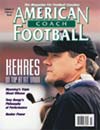Article CategoriesAFM Magazine
|
The Triple Shootby: Clancy BaroneFormer Offensive Line Coach, Wyoming, now at University of Houston © More from this issue During the early winter months of 1999 the University of Wyoming installed a new run-and- shoot-style offense called the "Triple Shoot." We knew going into the season that we would have the usual growing pains associated with the implementation of a new offense. We also had the added concern of starting three freshmen on the offensive line, a freshman at superback (running back) and a freshman in the starting rotation at receiver. We tried to stay as balanced as possible and were able to mix in a variety of play passes and action passes. It was our belief that to have success against more experienced defenses we would need to make a commitment to play passes and action passes. We truly believed that even the most disciplined defense on our schedule could have problems defending this aspect of our offense. This element of....The full article can only be seen by subscribers.
|
|
|||||||
| HOME |
MAGAZINE |
SUBSCRIBE | ONLINE COLUMNISTS | COACHING VIDEOS |
Copyright 2025, AmericanFootballMonthly.com
All Rights Reserved





